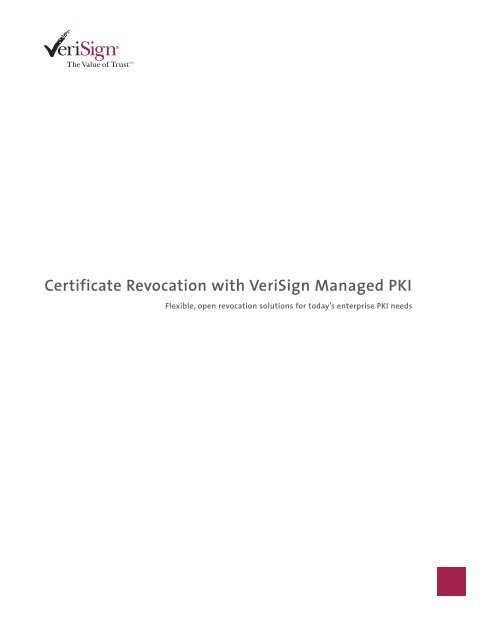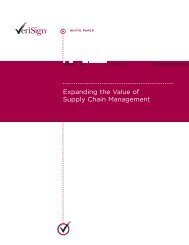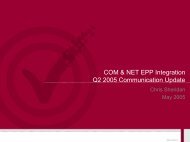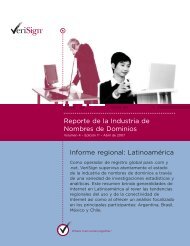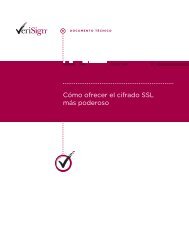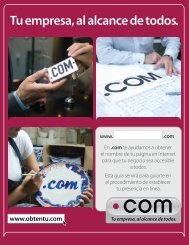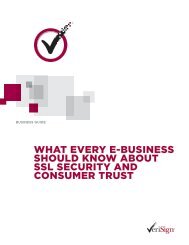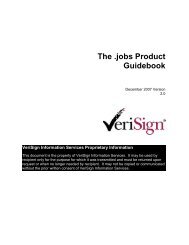Certificate Revocation with VeriSign Managed PKI - White Paper
Certificate Revocation with VeriSign Managed PKI - White Paper
Certificate Revocation with VeriSign Managed PKI - White Paper
You also want an ePaper? Increase the reach of your titles
YUMPU automatically turns print PDFs into web optimized ePapers that Google loves.
<strong>Certificate</strong> <strong>Revocation</strong> <strong>with</strong> <strong>VeriSign</strong> <strong>Managed</strong> <strong>PKI</strong>Flexible, open revocation solutions for today’s enterprise <strong>PKI</strong> needs
<strong>Certificate</strong> <strong>Revocation</strong> <strong>with</strong> <strong>VeriSign</strong> <strong>Managed</strong> <strong>PKI</strong>A <strong>VeriSign</strong> <strong>White</strong> <strong>Paper</strong>CONTENTSIntroduction 1To day’s Needs 1Available <strong>Revocation</strong> Mechanisms 3<strong>Certificate</strong> <strong>Revocation</strong> Lists (CRLs) 3Pa rtitioned CRLs 3Online <strong>Certificate</strong> Status Protocol (OCSP) 3Trusted Directories 4<strong>Revocation</strong> Functions in <strong>VeriSign</strong> <strong>Managed</strong> <strong>PKI</strong> 4Revoking a <strong>Certificate</strong> 4CRLs 4<strong>Managed</strong> <strong>PKI</strong> Validation Module for Web Servers 5Online Status (OCSP) 5Client-Side <strong>Revocation</strong> Checking 5Summary 6Open <strong>PKI</strong>—Best-of-Breed Applications 6More Options 6Lowest Total Cost 6Real-world Non-Repudiation 6Comparative Feature Support – <strong>VeriSign</strong>-Entrust 7
<strong>Certificate</strong> <strong>Revocation</strong> <strong>with</strong> <strong>VeriSign</strong> <strong>Managed</strong> <strong>PKI</strong>A <strong>VeriSign</strong> <strong>White</strong> <strong>Paper</strong>IntroductionIn a public-key infrastructure (<strong>PKI</strong>), digital certificates, signed by certification authorities(CAs), are the means of distributing public keys accurately and reliably to users needingto encrypt messages or verify digital signatures. A certificate has a fixed lifetime, typicallyone year. However, a certificate may need to be revoked by a CA if a user private key iscompromised or the CA is no longer willing to support the certification, for example,because the holder of the private key terminated employment <strong>with</strong> the enterprise.The<strong>PKI</strong> needs to provide applications that use certificates <strong>with</strong> the ability to check, at thetime of usage, that the certificate is still valid.<strong>VeriSign</strong> <strong>Managed</strong> <strong>PKI</strong> is <strong>VeriSign</strong>’s unique integrated <strong>PKI</strong> platform. 1 <strong>Managed</strong> <strong>PKI</strong>combines enterprise-controlled and operated <strong>PKI</strong> software/hardware, an open <strong>PKI</strong>architecture giving compatibility <strong>with</strong> all popular applications, and the certificate processingservices and infrastructure of a high-availability, high-security <strong>PKI</strong> backbone.The result isthe most fully-featured, cost-effective, high-availability, and high-security <strong>PKI</strong> solution forthe enterprise available in the world today.Easy-to-use, readily deployable certificate revocation is an important enterprise <strong>PKI</strong>requirement, and <strong>VeriSign</strong> has built into <strong>Managed</strong> <strong>PKI</strong> the best in revocation technology.<strong>Revocation</strong>, however, depends as much upon the application software product as it doesupon the infrastructure.Today’s <strong>PKI</strong>-enabled products include varying degrees of supportfor certificate revocation.Most of the application vendors participating in the Open <strong>PKI</strong> initiative 2 are respondingrapidly to customer revocation/status-checking requirements that are emerging as <strong>PKI</strong> isbeing progressively deployed in mainstream business applications. As these applicationsexpand their revocation/status-checking feature sets,<strong>VeriSign</strong> provides complementaryfunctions on the infrastructure side.This paper describes today’s revocation needs, available techniques for revocation/statuschecking,and <strong>VeriSign</strong>’s current products/services and strategic directions relating to thisaspect of <strong>PKI</strong>.In today’s fast-moving network security marketplace, it’s important to ensure thattoday’s <strong>PKI</strong> procurement decision won’t become obsolete tomorrow. The breadthand depth of <strong>VeriSign</strong>’s varied customer base and technical partners provides ourenterprise customers the utmost confidence that their <strong>PKI</strong> investment will growas their needs grow.Today’s NeedsDrawing on inputs gathered from over 120 <strong>VeriSign</strong> <strong>Managed</strong> <strong>PKI</strong> enterprise customers, plusprospective customers, affiliates, channel partners, and software vendor partners, and from theoperational experience gained from issuing and managing millions of consumer and Websitecertificates,<strong>VeriSign</strong> has assembled a clear picture of revocation requirements in enterprise<strong>PKI</strong> today.1
<strong>Certificate</strong> <strong>Revocation</strong> <strong>with</strong> <strong>VeriSign</strong> <strong>Managed</strong> <strong>PKI</strong>A <strong>VeriSign</strong> <strong>White</strong> <strong>Paper</strong>Available <strong>Revocation</strong> MechanismsDiscussions <strong>with</strong> our leading partners and major customers have conclusively establishedthat no single mechanism for certificate revocation will meet all needs. Risk managementpolicy, trust models, timeliness requirements, population size and relationships betweensubscribers and relying parties create a variety of complementary mechanisms. Let usexplain the mechanism options.<strong>Certificate</strong> <strong>Revocation</strong> Lists (CRLs)A certificate revocation list (CRL) is a digitally-signed, time-stamped black-list of revokedbut unexpired certificates, issued by a CA periodically, e.g., daily. CRLs have the attractionsof having a widely-recognized standard format (defined in the X.509 standard) and of beingsuitable for caching and use in non-online environments (e.g., when processing securee-mail in a client which is not currently network-connected).They have limitations inthat the CRL on hand may not be considered sufficiently fresh, and they may grow to anunacceptably large size.Partitioned CRLsTo counter the problems of CRLs growing too large, there are various mechanisms ofpartitioning a CRL into smaller pieces.The CRL distribution point (CDP) mechanismdefined in the X.509 standard provides for the population of users of a CA to be partitionedinto fixed groups, <strong>with</strong> each group having its own CRL. A pointer in the certificate indicatesthe CRL partition (group) appropriate for that certificate. Application software follows thislink to acquire the correct CRL partition.The group or link name is also included in theCRL and is used to confirm that this is the correct CRL for the certificate in question.For greater flexibility in partitioning CRLs,<strong>VeriSign</strong> developed the Open CDP (OCDP)mechanism. 3 Open CDP provides for CRL partitioning <strong>with</strong>out fixed pointers in certificates.Another mechanism defined in X.509 to help keep CRL sizes down is the delta CRLmechanism—a delta CRL contains only the latest revocation updates since a prior CRLwas issued.Online <strong>Certificate</strong> Status Protocol (OCSP)Some applications—such as high value funds transfer—require immediate on-line checkingof a certificate’s status, rather than tolerate any latency as in inherent in all CRL-basedmechanisms. An online mechanism is also ideally suited to integration of business processesthat are inherently transaction oriented, automated clearing-house (ACH) transactions beinga prime example. For such applications, the Internet Engineering Task Force (IETF)Public-Key Infrastructure X.509 (<strong>PKI</strong>X) Working Group developed the Online <strong>Certificate</strong>Status Protocol (OCSP) standard. OCSP species a transaction whereby a certificate-usingapplication can obtain from a CA a digitally-signed indication of the current status of anycertificate.While OCSP has excellent timeliness characteristics, it may present performanceproblems in comparison <strong>with</strong> CRLs, and is therefore not suitable for all applications.3
<strong>Certificate</strong> <strong>Revocation</strong> <strong>with</strong> <strong>VeriSign</strong> <strong>Managed</strong> <strong>PKI</strong>A <strong>VeriSign</strong> <strong>White</strong> <strong>Paper</strong><strong>Managed</strong> <strong>PKI</strong> Validation Module for Web ServersThis <strong>Managed</strong> <strong>PKI</strong> module satisfies the requirement for server-side revocation checking.It features:•A validation engine plug-in for Microsoft and Netscape Web Servers (IIS 4.0 and ES3.5.1 or above, respectively) that enforces access control certificate revocation.• Full configurability of CRL and CA certificate locations.• An API providing application-level access to the validation engine’s CRL maintenance,checking and automated retrieval functions.• Automatic download of the <strong>Managed</strong> <strong>PKI</strong> daily or hourly CRLs.<strong>VeriSign</strong>’s <strong>Managed</strong> <strong>PKI</strong> Validation Module provides turnkey revocation statuscheckingfor enterprise web servers that can operate <strong>with</strong> standard web browsers.In contrast, standalone <strong>PKI</strong> software vendors only implement revocation inconjunction <strong>with</strong> their proprietary client software products.Online Status (OCSP)<strong>VeriSign</strong> pioneered the development of real-time, automated status checking (OCSP). In theinterests of industry-wide interoperability, we initiated and led the effort <strong>with</strong> the InternetEngineering Task Force (IETF) to establish OCSP as an industry standard.We were the firstvendor to demonstrate OCSP operation in the 1998 National Automated ClearinghouseAssociation (NACHA) <strong>PKI</strong> trials and will provide OCSP support in conjunction <strong>with</strong>Netscape Communications Corporation’s implementation of this protocol (as announcedby Netscape in August, 1998).Client-Side <strong>Revocation</strong> CheckingClient-side revocation checking functions depend largely upon the implementationchoice of the client software vendor.<strong>VeriSign</strong> supports all the revocation mechanisms implementedby major vendors. For example, Microsoft has foreshadowed support for CRLs inforthcoming client product releases and Netscape has foreshadowed support for OCSP inits forthcoming releases.<strong>VeriSign</strong> <strong>Managed</strong> <strong>PKI</strong> will work <strong>with</strong> both as shipped—there is noneed for troublesome proprietary client plug-ins as needed <strong>with</strong> <strong>PKI</strong> offerings of standalone<strong>PKI</strong> software vendors.Furthermore,<strong>VeriSign</strong> supplies an application <strong>PKI</strong>-enablement toolkit that allows applicationimplementors to easily incorporate CRL-based revocation checking into their applications.5
<strong>Certificate</strong> <strong>Revocation</strong> <strong>with</strong> <strong>VeriSign</strong> <strong>Managed</strong> <strong>PKI</strong>A <strong>VeriSign</strong> <strong>White</strong> <strong>Paper</strong>SummaryOpen <strong>PKI</strong>—Best-of-Breed Applications<strong>VeriSign</strong>'s strategy has been to partner <strong>with</strong> leading software vendors such as Microsoft,Netscape or Cisco in producing <strong>PKI</strong>-enabled applications.This allows us to focus onestablishing and servicing the infrastructure that transforms commercial <strong>PKI</strong> into an integralcomponent of everyday business processes.The software vendors—and others—are movingswiftly to expand their <strong>PKI</strong> offerings to address the concerns of their leading customers.<strong>Revocation</strong> is high on the list of "must-haves".The <strong>VeriSign</strong> customer has the widestpossible set of deployment options, using industry leading <strong>PKI</strong>-enabled applications.More OptionsSome options—such as the trusted directory approach—are only useful in well-definedscenarios. CRLs, <strong>with</strong> or <strong>with</strong>out the various CRL-partitioning mechanisms, show mostpromise for interoperability. Lastly, there will exist high-value, mission-critical applicationsthat demand the immediate responsiveness and trust model flexibility that CRLs cannotprovide. OCSP meets this need.Lowest Total CostThe <strong>VeriSign</strong> customer buys much more than software.<strong>VeriSign</strong>’s integrated <strong>PKI</strong> platformsolution represents an investment in physical structures, high-availability systems, off-sitedisaster recovery facilities and key management hardware and software that are benchmarksfor the rest of the industry.We pioneered, developed and refined the commercialization ofkey management principles and processes which were previously only known to a selectfew <strong>with</strong>in the Defense community. More important, however, are the skilled andknowledgeable staff that are required to operate these types of facilities and execute thesehighly trusted processes.These costs—frequently overlooked in software-only comparisonsof <strong>PKI</strong> offerings—can make a massive difference for an enterprise considering a large,full-service operation.Real-world Non-Repudiation<strong>VeriSign</strong> <strong>Managed</strong> <strong>PKI</strong> supports non-repudiation in ways that are unattainable <strong>with</strong> fullyenterprise-operated standalone <strong>PKI</strong> products.With <strong>Managed</strong> <strong>PKI</strong>, while the enterprisehas full control over the issuance and revocation of digital certificates, complete recordsof the issuance and life cycle management of certificates are maintained by <strong>VeriSign</strong> ina high security, independently audited data center. Disaster recovery services operatearound-the-clock at a geographically separated backup site.<strong>VeriSign</strong>’s secure records are areadily available source of independent evidence that is available, if necessary, to facilitatespeedy dispute resolution.6
<strong>Certificate</strong> <strong>Revocation</strong> <strong>with</strong> <strong>VeriSign</strong> <strong>Managed</strong> <strong>PKI</strong>A <strong>VeriSign</strong> <strong>White</strong> <strong>Paper</strong>Comparative Feature Support – <strong>VeriSign</strong>-Entrust<strong>VeriSign</strong>’s features compare favorably <strong>with</strong> those of standalone <strong>PKI</strong> software product vendors.For example,Table 1 compares the <strong>VeriSign</strong> revocation features <strong>with</strong> those of Entrust.Feature <strong>VeriSign</strong> Entrust<strong>Managed</strong> <strong>PKI</strong>CRLs issued regularly YES YESServer-side revocation checking, working <strong>with</strong> YES NOstandard browsersAutomated revocation from enterprise administration system YES NOIndependently secured and verifiable revocation records YES NOto achieve non-repudiationDisaster recovery YES NOOnline <strong>Certificate</strong> Status Protocol (OCSP) YES NOOpen <strong>PKI</strong> toolkit for enabling revocation in applications YES NOFor Further Information......see our website at www.verisign.com, contact your local <strong>VeriSign</strong> AccountRepresentative, or call <strong>VeriSign</strong> at (650) 961-7500.1For further details, see "Public-Key Infrastructure--The <strong>VeriSign</strong> Difference," <strong>VeriSign</strong> Strategy <strong>White</strong> <strong>Paper</strong> #98-01, 1998.2See <strong>White</strong> <strong>Paper</strong> #98-01 for further details on Open <strong>PKI</strong>. Application vendors working on Open <strong>PKI</strong> initiatives <strong>with</strong> <strong>VeriSign</strong> includeMicrosoft, Netscape, and Lotus.3So named because this mechanism was developed originally as a free, "open" substitute for CDPs. The holder of the patent on CDPs wasattempting, at the time, to levy license fees across the <strong>PKI</strong> industry for the use of CDPs. Two days after the publication of <strong>VeriSign</strong>’s "OpenCDP," the demands for license fees on CDP usage were <strong>with</strong>drawn.©2004 <strong>VeriSign</strong>, Inc. All rights reserved.<strong>VeriSign</strong>, the <strong>VeriSign</strong> logo, NetSure, and other trademarks, service marks, and logos are registered or unregistered trademarks of <strong>VeriSign</strong> and its subsidiaries in the United States and other7


